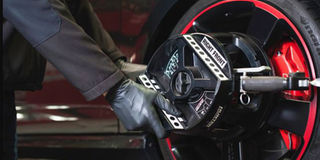Difference between wheel alignment and balancing

The purpose of these adjustments is maximum tyre life and a car that moves straight when driving along a straight and level road
Wheel alignment and balancing are two totally different things, but many people often get them confused. In a nutshell, wheel alignment consists of adjusting the angles of the wheels so that they are perpendicular to the ground and parallel to each other.
The purpose of these adjustments is maximum tyre life and a car that moves straight when driving along a straight and level road. Wheel balancing, on the other hand allows the tyres and wheels to spin without causing any vibrations. This is accomplished by checking for any heavy spots on the wheel-tyre combination and compensating for it by placing a measured lead weight on the opposite site of the wheel from where the heavy spot is.
Why?
Out-of-balance tyres will cause a car to vibrate at certain speeds, usually between 70 and 100kph. A tyre is out of balance when one section of the tyre is heavier than the others. To balance a wheel, the mechanic will mount it on a balancing machine that spins the wheel to locate the heavier part. He will then compensate for the heavy part by attaching a lead weight on the opposite side.
Most high quality wheels will hold their balance fairly well and go out of balance very gradually. If you notice a vibration that was not there the day before, it is possible that one of the lead balancing weights fell off. If you feel the vibration mostly in the steering wheel, the problem is most likely in a front wheel. If the vibration is mostly in the seat, the problem is probably in the rear wheels. Sometimes, your tyre could have a slight swelling that is causing the vibration.
Signs of bad alignment
The symptoms of a car that is out of alignment are, uneven or rapid tyre wear, pulling or drifting away from a straight line. To find out if you need an alignment, first check each tyre and look for uneven wear patterns. The problem with this method, however, is that if you can see a wear pattern, it may be too late to save that tyre. This is why it is a good idea to have your alignment checked periodically. Another indication of an out-of-alignment condition is a car that continuously drifts or pulls to one side of the road when you let go of the wheel.
A wheel alignment cannot be done on a car with loose or worn front-end parts. The mechanic will first check for worn parts and inform you of any problems before beginning the alignment. After the wheel alignment is finished, you should drive the car on a straight and level road and check that the car goes straight and that the steering wheel is in the proper position. If you notice a problem, take the car back and have the mechanic drive it and fine-tune the alignment settings.




